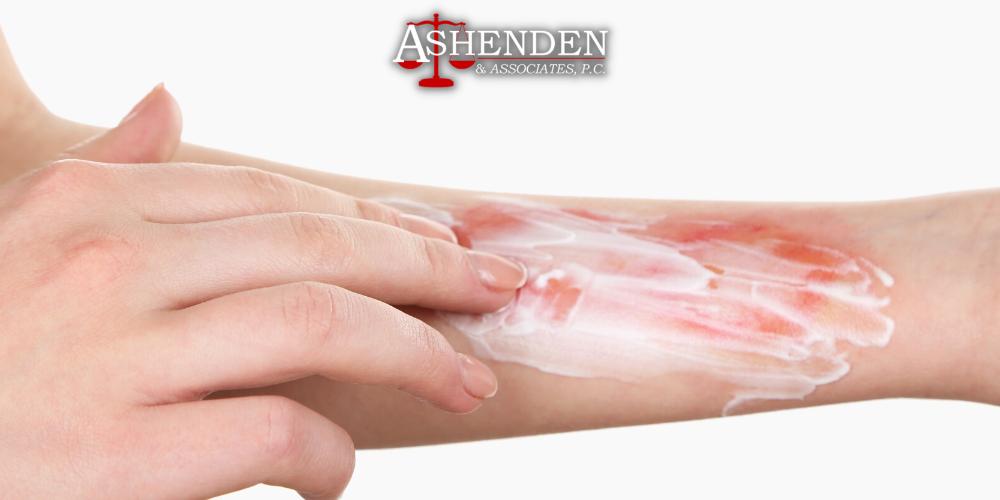We Go The Extra Distance For Our Clients
Practice Areas
Chemical Burn Accidents
A chemical burn occurs when the eyes, skin, or gastrointestinal tract comes into contact with a corrosive substance, such as an acid or a base. Acid and chemical burns, even minor ones, require immediate medical attention in order to prevent major complications such as necrosis, amputations, and even death. The medical treatment and missed work days associated with chemical burn accidents can lead to thousands of dollars of debt. Thankfully, chemical burn victims can pursue financial compensation through a personal injury lawsuit if their injuries were caused by someone else’s negligence. Sandy Springs personal injury lawyers at Ashenden & Associates have the skill and experience necessary to help you obtain justice for your suffering. Call 770-394-8909 to schedule a free consultation at our law firm today.

What is a Chemical Burn?
Chemical burns (also known as caustic burns) occur when the skin, eyes, or internal organs come into contact with dangerous chemicals. Most chemical burns occur when someone spills, splashes, or swallows a corrosive substance. Minor chemical burns can heal fairly quickly with appropriate treatment from a healthcare professional, and they usually don’t lead to long term damage. However, severe chemical burns can be life-threatening and can result in permanent tissue damage.
How Common Are Chemical Burns?
According to a 2019 study, chemical burns make up nearly 11% of all burns and 30% of deaths due to burn injuries. The majority of chemical burn victims are children who spill or drink household products, such as cleaning products.
Types of Chemical Burns
Just like burns caused by fire or the sun, chemical burns are classified by three degrees.
- First Degree Burn: This type of burn is characterized by tissue damage to the outer layer of skin, called the epidermis. First degree burns are minor and can heal quickly with minimal medical intervention.
- Second Degree Burn: This type of burn is characterized by tissue damage to the second layer of skin, called the dermis. Many people experience redness, swelling, blistering, and pain with second degree burns.
- Third Degree Burn: This type of burn is characterized by damage to the third layer of skin, called the hypodermis or subcutaneous tissue. Most people experience damaged nerves, hair follicles, and sweat glands from their third degree burns. Because the tissue is likely damaged and black in color, many people have to get skin grafts in order to heal from their injuries.

What Causes Chemical Burns?
Chemical injuries are usually caused by strong acids and bases. The most common toxic chemicals that lead to chemical burns include:
- Drain cleaners
- Rust removers and metal cleaners
- Car battery acid
- Household products such as bleach, detergents, toilet bowl cleaners, and other disinfectants
- Detergents
- Wet cement
- Paint removers
- Hair relaxers
- Pesticides and fertilizers
- Chlorine and other swimming pool chemicals
- Ammonia
- Denture cleaners and other teeth whitening products
People who work around harsh chemicals – such as farmers, construction workers, mechanics, plumbers, factory workers, lab technicians, military members, etc. – are the most likely to suffer from a dangerous chemical injury.
Additionally, children account for a large number of chemical injuries because their parents may store chemicals in old food or drink containers. So the child may mistake the chemical for a drink, and either spill it on themselves or swallow it. Even chemicals stored in their original containers can be dangerous to children, especially if the chemicals have open lids or they’re not stored out of reach.
Chemical Burn Symptoms
Symptoms of a chemical burn on the skin may include:
- Redness or skin discoloration
- Pain
- Swelling
- Blistering or scabbing
- Dry, cracking, and/or peeling skin
Symptoms of eye burns caused by harsh chemicals may include:
- Red eyes
- Stinging or burning pain in the eyes
- Blurry vision
- Swelling of the eyelids
- Watery eyes
- Blindness (in the case of severe injuries)
Chemical burns in the gastrointestinal tract may lead to the following symptoms:
- Nausea and vomiting
- Vomiting blood
- Chest pain
- Coughing
- Difficulty talking
- Shallow breathing
- Weak pulse
- Clammy skin
- Drooling
- Swelling of the upper airway
- Mouth and throat pain while swallowing
- Holes in the stomach or esophagus
- Low blood pressure
- Dizziness
- Seizures
- Muscle weakness or twitching
- Headache
What To Do After a Chemical Burn
Chemical burns, even minor ones, are dangerous and require emergency medical attention. This is what you should do after you or someone you love comes into contact with toxic chemicals:
- Call 911: Even if you think your burn is minor, you should still seek emergency care by calling 911 or asking a friend to drive you to the emergency room.
- Call the Local Poison Control Center: If you or a loved one accidentally ingested a toxic chemical, you should also call the poison control center. They can give you specific instructions based on the type of substance ingested. They may also direct you to the emergency department.
- Drink Water: If you or a loved one ingested chemicals, you should drink water to try to dilute the substance in your stomach. Do not induce vomiting on your own (unless a healthcare provider specifically tells you to do so) because the chemical can cause more burn damage coming back up the esophagus.
- Remove Contaminated Clothing: If you spilled a chemical on yourself and your clothes, you need to remove the contaminated clothing immediately. Be sure to do this with gloves on, and try not to touch other areas of your body with the contaminated clothes.
- Rinse the Affected Area With Water: Rinse the eyes or burned skin under cool water until emergency personnel arrive. However, if you came into contact with sulfuric acid, carbolic acid, dry powders, or metal compounds, you should not rinse with water.
Chemical Burn Treatment
The specific protocol for treating a chemical burn depends on the location and severity of the injury. Basic medical treatment will likely include NSAIDs to control pain, antibiotics to prevent infection, and a dry sterile dressing applied to the burned area. Severe cases of chemical burns on the skin may require a skin graft, which is when a doctor takes healthy skin from another body part and stitches it onto the burned, dead skin.
Medical treatment for someone who has ingested a toxic substance will heavily depend on the patient’s symptoms and the type of substance ingested. Medical professionals may control the poisoning symptoms with medications and they may even suction the contents out of the patient’s stomach. If the ingested chemicals created holes in the stomach or esophagus, the patient will need surgery to repair the damage.

Chemical Burn Complications
Severe chemical burns can lead to the health complications listed below, especially without emergency medical help.
- Major scarring and disfigurement
- Amputations
- Infection
- Muscle and tissue damage
- Psychological distress such as depression, anxiety, hopelessness, panic attacks, flashbacks to the burning incident, nightmares, and more
- Death
Can You Sue for Chemical Burns?
Yes, you can definitely sue for a chemical burn caused by someone else’s negligence. Chemical burns can happen at work, on construction sites, or during major car accidents. Most chemical burns require emergency medical attention and follow up care, which can lead to thousands of dollars of medical debt. Not only that, but severe burns can force victims to take weeks or months off work in order to recover. So on top of the medical debt, many people have to worry about lost income as well. The negligent party should provide compensation for these damages.
Just like any other successful personal injury case, though, it’s crucial to prove the 4 elements of negligence:
- Duty of Care: The negligent party owed you a duty of care to provide you a safe environment to work or exist in.
- Breached Duty of Care: The negligent party breached this duty of care by failing to handle dangerous chemicals properly or failing to instruct you how to handle the chemicals properly.
- Causation: The at-fault party’s negligent actions or inactions directly caused your chemical injury.
- Damages: The burn injury caused you to suffer a variety of damages, and you should receive financial compensation for these damages.
The Sandy Springs personal injury lawyers at Ashenden & Associates can help you prove these elements of negligence through medical records, security camera footage, witness statements, accident reconstruction, police reports, etc. If you’re planning to sue someone for a major accident or injury, you should always hire experienced legal counsel first.
Chemical Burn Damages
A Sandy Springs personal injury lawyer can help victims of chemical burn accidents recover compensation for the following damages:
- Past and future medical bills
- Lost wages
- Loss of earning capacity
- Physical pain and suffering
- Permanent scarring and disfigurement
- Emotional distress
- Mental health counseling bills
- Funeral and burial expenses if severe burns lead to wrongful death

Call a Sandy Springs Personal Injury Lawyer at Ashenden & Associates Today
If you suffered chemical burns caused by someone else’s negligence, you have grounds to file a personal injury lawsuit in order to recover financial compensation. Chemical burns can lead to months of downtime and thousands of dollars in medical debt. Not to mention, burns are incredibly painful. You deserve justice and financial compensation for the physical, mental, and financial distress you have suffered. Hiring a Sandy Springs personal injury lawyer can help you build a strong case so that you can obtain that justice and compensation. Call 770-394-8909 to schedule a free consultation at Ashenden & Associates today.

